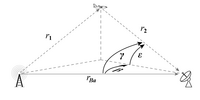Bistatic radar

A bistatic radar is like a game of catch where we have two players: one who throws the ball and another who catches the ball. But in this game, we are using radio waves to send and receive signals instead of throwing and catching a ball.
Imagine we have a special radar system that uses two antennas instead of one. One antenna is called the "transmitter," and it sends out radio waves into the sky. The other antenna is called the "receiver," and it picks up the radio waves that bounce back.
Now, let's say we want to find out the location of an airplane that's flying in the sky. We point the transmitter antenna towards the sky and send out radio waves. These radio waves hit the airplane and bounce back towards the earth, where they get picked up by the receiver antenna.
But wait, there's a catch! The receiver antenna is not located where the transmitter antenna is. Instead, it's situated somewhere else, a distance away from the transmitter. This means we have two different locations where radio waves are being sent and received - hence the name "bistatic" radar.
The receiver antenna receives the signal from the airplane and sends it to a computer. The computer then calculates the distance between the transmitter, the airplane, and the receiver. Using this information, we can figure out the location of the airplane.
Bistatic radars have some advantages over traditional monostatic radars (using only one antenna). For example, they are harder to detect, as the receiver antenna can be placed far away from the transmitter. Also, they can detect targets that are otherwise invisible to monostatic radars, like airplanes that are flying low to the ground.
In a nutshell, a bistatic radar is like having two different players in our catch game - one to throw the ball and another to catch it. By using two antennas, we can locate objects in the sky that we couldn't with just one antenna.
Imagine we have a special radar system that uses two antennas instead of one. One antenna is called the "transmitter," and it sends out radio waves into the sky. The other antenna is called the "receiver," and it picks up the radio waves that bounce back.
Now, let's say we want to find out the location of an airplane that's flying in the sky. We point the transmitter antenna towards the sky and send out radio waves. These radio waves hit the airplane and bounce back towards the earth, where they get picked up by the receiver antenna.
But wait, there's a catch! The receiver antenna is not located where the transmitter antenna is. Instead, it's situated somewhere else, a distance away from the transmitter. This means we have two different locations where radio waves are being sent and received - hence the name "bistatic" radar.
The receiver antenna receives the signal from the airplane and sends it to a computer. The computer then calculates the distance between the transmitter, the airplane, and the receiver. Using this information, we can figure out the location of the airplane.
Bistatic radars have some advantages over traditional monostatic radars (using only one antenna). For example, they are harder to detect, as the receiver antenna can be placed far away from the transmitter. Also, they can detect targets that are otherwise invisible to monostatic radars, like airplanes that are flying low to the ground.
In a nutshell, a bistatic radar is like having two different players in our catch game - one to throw the ball and another to catch it. By using two antennas, we can locate objects in the sky that we couldn't with just one antenna.
Related topics others have asked about:
